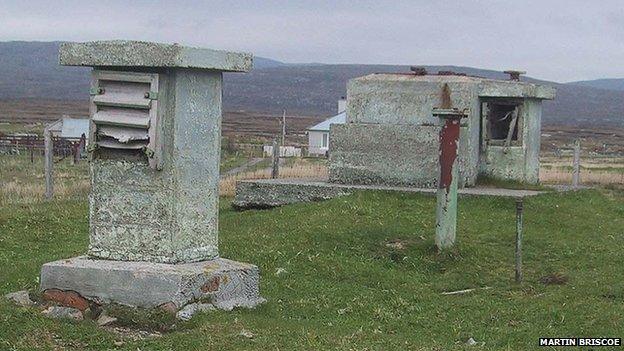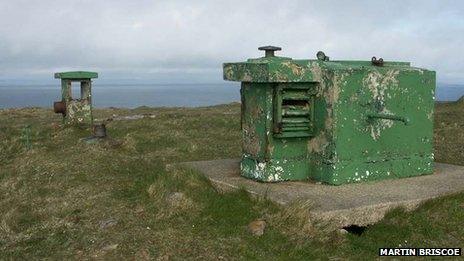The underground Cold War sites on your doorstep
- Published

A Royal Observer Corps monitoring post at Lochboisdale in the Western Isles
Fifty years after the Cuban Missile Crisis pushed the world to the brink of nuclear war there is growing interest in protecting relics from that time and many are closer to home than you might think.
Dotted across the countryside are unremarkable concrete structures with flaking green paint and rusty metal hatches.
The weathered concrete and steel is all that can be seen above ground of the small Royal Observer Corps (ROC) monitoring posts buried 6ft underground.
Until 21 years ago, they would have been on the front line in the event of a nuclear attack on the UK, providing a place for ROC volunteers to measure nuclear blast waves and radioactive fallout.
Between 1956 and 1965, the UK government ordered the construction of 1,563 monitoring posts at a distance of about 15 miles apart. Thirty-one larger HQ and control centres were also built.
All the sites were closed down when the ROC was stood down in 1991, as the Cold War came to end with the disintegration of the Soviet Union.
According to the ROC Association, the vast majority of the monitoring posts were demolished, left to fall into disrepair, or vandalised and then flooded with rainwater.
About 70 have been preserved by private individuals, trusts or heritage agencies. A handful are open to the public on a regular basis, including posts at Arbroath in Angus, Broadway Tower in Worcestershire and Veryan in Cornwall. Surviving examples of the first posts to be built can be found at Rushton Spencer in Staffordshire and Dersingham in Norfolk.
English Heritage has saved a control centre at York, while the Civil Defence and Emergency Service Preservation Trust is restoring Dundee Group Control.
Allan Kilpatrick, an archaeologist at the Royal Commission on the Ancient and Historical Monuments of Scotland (RCAHMS), said there was an increasing interest in the UK's Cold War sites.
He said even rarer than the monitoring posts were surviving examples of the basic, above-ground Orlit A posts which the ROC used from the end of World War II until 1955.
These were for plotting flights of Russian aircraft in the event of World War III breaking out, but were abandoned when long-range nuclear missiles became the threat and work on underground posts began.
"The underground posts were fairly rudimentary," said Mr Kilpatrick.
"There was a ladder down to a room and a toilet. A pipe extending above ground had instruments on it to measure the blast wave.
"Once the measurements had been made and the information sent, the job of a post's three personnel was then to monitor the fallout. The posts did not have a sophisticated ventilation system, the air coming down from the outside was not filtered. It's not hard to imagine these posts becoming a coffin really."
Mr Kilpatrick said some might be surprised by how many underground posts were in their local area.
He said: "Just for example, if you went from Inverness to the west coast you would pass several posts. There would be one at Muir of Ord, Garve, Achnasheen, Kinlochewe and Gairloch."
The archaeologist said it was important that "at the very least" the locations of UK Cold War sites should be recorded, something he said some groups and organisations were already doing.
But he added that it was not always easy to accurately document the locations following his experience of an excavation of a site at Whitby in North Yorkshire in advance of new construction work.
He said: "There was a very strange and unexpected group of structures uncovered by the excavation. In order to keep the ROC site secret it had been given a grid reference on maps that was different from where it actually was."
Former ROC officer Lawrence Holmes has been impressed by the efforts to preserve the small number of posts and controls.
He said: "Very quickly after stand down most post sites were offered back to the original land owners, demolished or sold off.
"In the years since stand down many more posts have been demolished, some with indecent haste, and many more are now in a poor state of repair, particularly those closed in 1968.

About 70 of the 1,563 underground monitoring posts have been saved
"Only a relatively small percentage of the total have been preserved and these mainly by volunteers.
"Perhaps strangely, many of the posts have been acquired for preservation by non-ROC people and members of Subterranea Britannica are amongst the most avid ROC post owners."
'Becoming rarer'
For Mr Holmes memories of the practical purposes of the sites has not dimmed.
He said: "The ROC was a very well organised, systematic organisation which met every week and practiced their nuclear war games very often, if not always, in their underground, or protected bunkers."
The volunteers trained for duties that were to be carried out during the launch of a nuclear attack and were to continue to operate as the missiles fell and exploded. ROC personnel were also expected to carry on with their duties for up to three weeks after an attack.
Gavin Saxby, who is helping the Civil Defence and Emergency Service Preservation Trust restore the former Dundee Group Control, said preserving sites and the equipment which was used acknowledged the sacrifices ROC volunteers were prepared to make.
"For some the Cold War is too recent to be history," he said.
"But now is a time when we can still reach back and touch the people who lived through it and when we can also still gather the artefacts, which are becoming rarer."
Mr Saxby added: "We owe it to future generations to look after the sites and artefacts, to have them for research purposes and not let things decay."
- Published25 October 2012
- Published10 October 2012